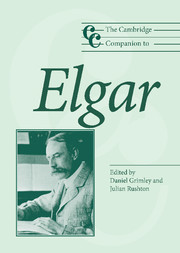Book contents
- Frontmatter
- 1 Introduction
- 2 Elgar and his British contemporaries
- 3 Elgar and his publishers
- 4 Magic by mosaic: some aspects of Elgar's compositional methods
- 5 Elgar's musical language: the shorter instrumental works
- 6 The early choral works
- 7 Elgar's later oratorios: Roman Catholicism, decadence and the Wagnerian dialectic of shame and grace
- 8 Roman Catholicism and being musically English: Elgar's church and organ music
- 9 ‘A smiling with a sigh’: the chamber music and works for strings
- 10 In search of the symphony: orchestral music to 1908
- 11 The later orchestral music (1910–34)
- 12 Elgar's unwumbling: the theatre music
- 13 Elgar and recording
- 14 Broadcasting's ally: Elgar and the BBC
- 15 Elgar in German criticism
- 16 Functional music: imperialism, the Great War, and Elgar as popular composer
- Notes
- Select bibliography
- Index
4 - Magic by mosaic: some aspects of Elgar's compositional methods
Published online by Cambridge University Press: 28 September 2011
- Frontmatter
- 1 Introduction
- 2 Elgar and his British contemporaries
- 3 Elgar and his publishers
- 4 Magic by mosaic: some aspects of Elgar's compositional methods
- 5 Elgar's musical language: the shorter instrumental works
- 6 The early choral works
- 7 Elgar's later oratorios: Roman Catholicism, decadence and the Wagnerian dialectic of shame and grace
- 8 Roman Catholicism and being musically English: Elgar's church and organ music
- 9 ‘A smiling with a sigh’: the chamber music and works for strings
- 10 In search of the symphony: orchestral music to 1908
- 11 The later orchestral music (1910–34)
- 12 Elgar's unwumbling: the theatre music
- 13 Elgar and recording
- 14 Broadcasting's ally: Elgar and the BBC
- 15 Elgar in German criticism
- 16 Functional music: imperialism, the Great War, and Elgar as popular composer
- Notes
- Select bibliography
- Index
Summary
If a stranger had asked Elgar ‘How do you compose?’ they would be very lucky to have received a reasoned answer. More likely, they might have been met with a curt rebuff or a tirade of banter. Yet Elgar might have responded more seriously to the question if he felt that the person was genuinely sympathetic to his own personality as well as to his music. Fortunately, we do not have to rely on anecdotes to answer this question. Instead, we have a plethora of documentary manuscript materials: sketchbooks, working sketches, short scores, full scores and sets of corrected proofs from which we can follow the creative habits of his entire life and gain invaluable perspectives on his stylistic growth from juvenilia to maturity. However, there have been some losses, as his daughter Carice noted when he moved from Severn House, Hampstead in July 1921, just over a year after the death of Lady Elgar: ‘Very busy day – turning out stationery cupboard – Father went through all his sketches MSS etc. sad work. Destroyed much & got it all in order. He spent a second day at the task.’
Elgar's manuscripts are not the only answer to our initial question: he was not alone among the composers of his age, nor since, who are conveniently labelled ‘Romantic’ on account of their sincere indebtedness to the stimuli they received from environments and literature. It was to Robert J. Buckley that Elgar revealed the early importance of environment:
The composer once related an incident to his first biographer . . . when he was nine or ten years old Edward Elgar was discovered sitting on a bank by the river with pencil and a piece of paper whereon were ruled five parallel lines. He was trying, he said, to write down what the reeds were singing.
- Type
- Chapter
- Information
- The Cambridge Companion to Elgar , pp. 32 - 49Publisher: Cambridge University PressPrint publication year: 2005



